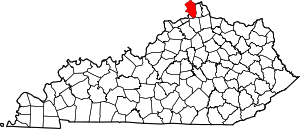Boone County, Kentucky
Boone County | |
|---|---|
U.S. county | |
 The old Boone County courthouse in Burlington | |
 Location within the U.S. state of Kentucky | |
 Kentucky's location within the U.S. | |
| Coordinates: 38°58′N 84°44′W / 38.97°N 84.73°W | |
| Country | |
| State | |
| Founded | 1798 |
| Named for | Daniel Boone |
| Seat | Burlington |
| Largest city | Florence |
| Area | |
| • Total | 256 sq mi (660 km2) |
| • Land | 246 sq mi (640 km2) |
| • Water | 10 sq mi (30 km2) 3.9%% |
| Population (2020) | |
| • Total | 135,968 |
| • Density | 349/sq mi (135/km2) |
| Time zone | UTC−5 (Eastern) |
| • Summer (DST) | UTC−4 (EDT) |
| Congressional district | 4th |
| Website | www |
Boone County is a county located in the northern part of the U.S. state of Kentucky. As of the 2020 census, the population was 135,968,[1] making it the fourth-most populous county in Kentucky. Its county seat is Burlington.[2] The county was formed in 1798 from a portion of Campbell County.[3] and was named for frontiersman Daniel Boone.[4]
Boone County, with Kenton and Campbell Counties, is of the Northern Kentucky metro area, and the Cincinnati-Middletown, OH-KY-IN Metropolitan Statistical Area. It is the location of the Cincinnati/Northern Kentucky International Airport, which serves Cincinnati and the tri-state area and was the former headquarters of Comair.
History[]
Native Americans had once inhabited a large late historic village in Petersburg that contained "at least two periods of habitation dating to 1150 A.D. and 1400 A.D."[5]
In 1729 an unknown Frenchman sketched an area on his chart at what is now Big Bone Lick State Park with a note that it was "where they found the bones of an elephant."[5] Another Frenchman, Charles le Moyne de Longueuil (1687–1755), would later be credited with being the first to investigate the Big Bone Lick area.[5]
In 1789, 10-year-old John Tanner was captured by Ojibwe Indians across from the mouth of the Great Miami River, while his Baptist minister father, brother, and their slaves were planting corn.
Boone County was created in 1798, and named after Daniel Boone.
Margaret Garner[]
On January 28, 1856, Robert and a pregnant Margaret "Peggy" Garner, together with family members, escaped and fled to Cincinnati, Ohio, along with several other slave families. Seventeen people were reported to have been in their party. In the coldest winter in 60 years, the Ohio River had frozen. The group crossed the ice just west of Covington, Kentucky at daybreak, and escaped to Cincinnati, then divided to avoid detection. They set out for Joseph Kite's house in Cincinnati.[6]
Margaret Garner would become famous for slitting her own daughter's throat (Mary) to prevent her from going back into slavery when Archibald K. Gaines and his posse, along with Federal Marshals, caught up to the fleeing slaves at Joseph Kite's house.[6]
Margaret Garner was first owned by, and may have been the daughter of, the plantation owner John Pollard Gaines himself.[7] In December 1849, the plantation was along with all the slaves to John P. Gaines' younger brother, Archibald K. Gaines.[7] The Gaines family lived on a farm called Maplewood in Boone County, Kentucky, just west of Richwood Presbyterian Church, of which Archibald K. Gaines was a member.[8] Three of Margaret Garner's children, including Mary, the daughter whose throat Margaret Garner slashed, were likely the children of Archibald K. Gaines, the only adult white male at Maplewood. The timing suggests they were each conceived after his wife had become pregnant and was unavailable to him.[9]
Margaret Garner's story was the inspiration for the novel Beloved (1987) by Nobel Prize winner Toni Morrison (that later was adapted into a film of the same name starring Oprah Winfrey), as well as for her libretto for the early 21st century opera Margaret Garner (2005), composed by Richard Danielpour.
Geography[]
According to the U.S. Census Bureau, the county has a total area of 256 square miles (660 km2), of which 246 square miles (640 km2) is land and 10 square miles (26 km2) (3.9%) is water.[10] Its location along the Ohio River was key to its early development, as the river was the major transportation route.
Adjacent counties[]
- Hamilton County, Ohio (north)
- Kenton County (east)
- Grant County (south)
- Gallatin County (southwest)
- Switzerland County, Indiana (west)
- Ohio County, Indiana (west)
- Dearborn County, Indiana (northwest)
Demographics[]
| Historical population | |||
|---|---|---|---|
| Census | Pop. | %± | |
| 1800 | 1,534 | — | |
| 1810 | 3,608 | 135.2% | |
| 1820 | 6,542 | 81.3% | |
| 1830 | 9,075 | 38.7% | |
| 1840 | 10,034 | 10.6% | |
| 1850 | 11,185 | 11.5% | |
| 1860 | 11,196 | 0.1% | |
| 1870 | 10,696 | −4.5% | |
| 1880 | 11,996 | 12.2% | |
| 1890 | 12,246 | 2.1% | |
| 1900 | 11,170 | −8.8% | |
| 1910 | 9,420 | −15.7% | |
| 1920 | 9,572 | 1.6% | |
| 1930 | 9,595 | 0.2% | |
| 1940 | 10,820 | 12.8% | |
| 1950 | 13,015 | 20.3% | |
| 1960 | 21,940 | 68.6% | |
| 1970 | 32,812 | 49.6% | |
| 1980 | 45,842 | 39.7% | |
| 1990 | 57,589 | 25.6% | |
| 2000 | 85,991 | 49.3% | |
| 2010 | 118,811 | 38.2% | |
| 2020 | 135,968 | 14.4% | |
| U.S. Decennial Census[11] 1790–1960[12] 1900–1990[13] 1990–2000[14] 2010–2019[1] | |||
As of the census[15] of 2000, there were 85,991 people, 31,258 households, and 23,443 families residing in the county. The population density was 349 per square mile (135/km2). There were 33,351 housing units at an average density of 135 per square mile (52/km2). The racial makeup of the county was 95.15% White, 1.52% Black or African American, 0.23% Native American, 1.29% Asian, 0.03% Pacific Islander, 0.75% from other races, and 1.03% from two or more races. 1.98% of the population were Hispanic or Latino of any race.
There were 31,258 households, out of which 39.80% had children under the age of 18 living with them, 61.60% were married couples living together, 9.80% had a female householder with no husband present, and 25.00% were non-families. 20.20% of all households were made up of individuals, and 6.20% had someone living alone who was 65 years of age or older. The average household size was 2.73 and the average family size was 3.17.
In the county, the population was spread out, with 28.70% under the age of 18, 8.50% from 18 to 24, 33.50% from 25 to 44, 21.30% from 45 to 64, and 8.10% who were 65 years of age or older. The median age was 33 years. For every 100 females there were 97.70 males. For every 100 females age 18 and over, there were 94.70 males.
The median income for a household in the county was $53,593, and the median income for a family was $61,114. Males had a median income of $42,105 versus $27,414 for females. The per capita income for the county was $23,535. About 4.40% of families and 5.60% of the population were below the poverty line, including 6.40% of those under age 18 and 7.70% of those age 65 or over.
Politics[]
Boone County is a solidly Republican county in presidential elections; the last time it voted Democratic was in 1964, when Lyndon B. Johnson won in a national landslide. In 1976, however, the county gave exactly the same number of votes to Democrat Jimmy Carter and Republican Gerald Ford.
Economy[]
Boone County is the location of the Cincinnati/Northern Kentucky International Airport, which includes the headquarters of DHL Express, Southern Air and Delta Private Jets.[18][19]
Major attractions[]
The Creation Museum (Petersburg), operated by the apologetics ministry Answers in Genesis, as well as Big Bone Lick State Park, "birthplace of American paleontology," are located in Boone County.[20]
Communities[]
Cities[]
Census-designated places[]

- Burlington (county seat)
- Francisville
- Hebron
- Oakbrook
- Petersburg
- Rabbit Hash
- Verona
Other unincorporated communities[]
The Disunited States of America[]
In the novel The Disunited States of America, written by Harry Turtledove, the county of Boone is its own separate state.
See also[]
- Abner Gaines House
- Big Bone Lick State Park
- Boone County Arboretum
- Dinsmore Homestead
- East Bend, Kentucky
- National Register of Historic Places listings in Boone County, Kentucky
- Richwood Presbyterian Church
References[]
- ^ Jump up to: a b "State & County QuickFacts". United States Census Bureau. Archived from the original on July 7, 2011. Retrieved March 5, 2014.
- ^ "Find a County". National Association of Counties. Archived from the original on 2011-05-31. Retrieved 2011-06-07.
- ^ Collins, Lewis (1882). Collins' Historical Sketches of Kentucky: History of Kentucky, Volume 2. Collins & Company. p. 26.
- ^ The Register of the Kentucky State Historical Society, Volume 1. Kentucky State Historical Society. 1903. p. 34.
- ^ Jump up to: a b c "Archived copy". Archived from the original on August 11, 2014. Retrieved October 4, 2014.CS1 maint: archived copy as title (link)
- ^ Jump up to: a b "Margaret Garner Incident (1856) | The Black Past: Remembered and Reclaimed". The Black Past. Retrieved 2016-04-12.
- ^ Jump up to: a b Steven Weisenburger, "A Historical Margaret Garner" Archived 2011-05-20 at the Wayback Machine, Michigan Opera Theatre, accessed 20 April 2009
- ^ "Richwood, Kentucky". Nkyviews.com. Retrieved 2016-04-12.
- ^ Steven Weisenburger, "A Historical Margaret Garner" Archived 2011-05-20 at the Wayback Machine, Michigan Opera Theatre, accessed 20 April 2009. "Bertram Wyatt-Brown reminds us, Southern men commonly referred to their pregnant wives' last trimester or so when they were sexually unavailable as "the gander months" because it was supposedly natural, and to some extent informally countenanced, for them to seek intimate "comfort" with unmarried women or with enslaved women, if they owned any."
- ^ "2010 Census Gazetteer Files". United States Census Bureau. August 22, 2012. Archived from the original on August 12, 2014. Retrieved August 12, 2014.
- ^ "U.S. Decennial Census". United States Census Bureau. Retrieved August 12, 2014.
- ^ "Historical Census Browser". University of Virginia Library. Retrieved August 12, 2014.
- ^ "Population of Counties by Decennial Census: 1900 to 1990". United States Census Bureau. Retrieved August 12, 2014.
- ^ "Census 2000 PHC-T-4. Ranking Tables for Counties: 1990 and 2000" (PDF). United States Census Bureau. Retrieved August 12, 2014.
- ^ "U.S. Census website". United States Census Bureau. Retrieved 2008-01-31.
- ^ Leip, David. "Dave Leip's Atlas of U.S. Presidential Elections". uselectionatlas.org.
- ^ http://geoelections.free.fr/. Retrieved January 13, 2021. Missing or empty
|title=(help) - ^ "Career Area Archived 2008-05-21 at the Wayback Machine." Comair. Retrieved on May 19, 2009.
- ^ "Contact Us Archived 2010-09-30 at the Wayback Machine." Delta Private Jets. Retrieved on October 3, 2010.
- ^ "HomeTownLocator". Hometownlocator.com. Retrieved 2006-06-10.
External links[]
- Kentucky counties
- Boone County, Kentucky
- 1798 establishments in Kentucky
- Kentucky counties on the Ohio River


